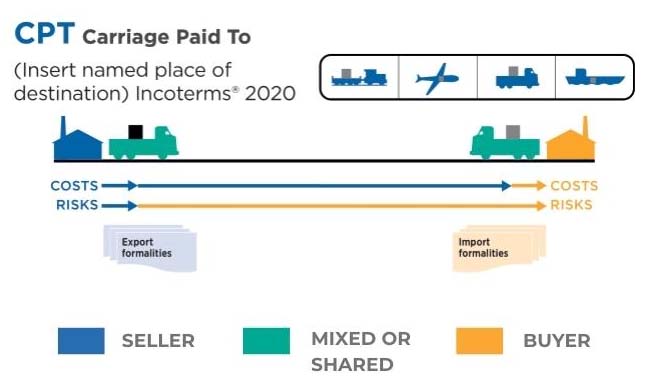CPT Carriage Paid To:付费通道
根据 CPT 术语 "运费付至"(Carriage Paid To),卖方支付运至指定目的地的运费,但一旦货物交给第一承运人,风险就转移给买方。想象一下,你在火车上,舒适地坐在座位上,知道你的车票已经付款。这就是 CPT。 CPT 于 1980 年推出,是 CFR 的现代转折,反映了从海运到多式联运的转变。
卖方义务:
在指定装运地点将货物交给承运人。
支付前往指定目的地的交通费用。
为出口货物清关。
买方义务:
办理货物进口清关手续,支付所有关税。
承担货物交付给承运人后的所有损失或损坏风险。

CPT 实例:
CPT:运费付至
让我们用一个例子来解释 Incoterm CPT(运费到付)下的定价和运输。
我们可以用这样一个场景来说明:中国卖家向美国买家运送电子产品。
以下是费用的细分情况:

- 产品成本: 电子设备的商定价格为 $20,000 美元。
- 当地物流: 将货物从仓库运送到中国港口的费用(卖方负责),假设为 $1,000 美元。
- 出口清关: 中国海关货物出口清关费用(卖方负责),例如 $500。
- 运费: 将货物漂洋过海运至美国目的港的运费(根据 CPT,卖方负责),假设为 $2,000 美元。
因此,卖方的总成本(CPT 价格)为 $20,000 + $1,000 + $500 + $2,000 = $23,500 。
运输:
- 进口清关: 美国海关清关货物的关税(买方负责),假设为 $3,000。
- 当地物流: 将货物从港口运送到买方在美国的仓库的费用(买方负责),假设为 $1,000 美元。
因此,买方的总成本应为 CPT 价格($23,500)加上进口清关费用($3,000)和当地物流费用($1,000)。也就是说,$23,500 + $3,000 + $1,000 = $27,500。
在 CPT 下,卖方有义务安排并支付将货物运至约定目的地的运输费用,但一旦货物交给第一承运人,风险就从卖方转移到买方,这与 FOB 术语不同。
哪个术语与 CPT 无关?
与 CPT 最相似的 Incoterm 是 CIP (运费和保险费付至)。两者都要求卖方安排并支付将货物运输到指定目的地的费用。主要区别在于,根据 CIP,卖方还必须为买方在运输过程中的货物灭失或损坏风险购买保险并支付保险费。在这两种条件下,卖方都需要安排运输并支付运输费用,但只有在 CIP 条件下,卖方还必须安排保险。在这两种情况下,一旦货物交给第一承运人,灭失或损坏的风险就从卖方转移到买方。


